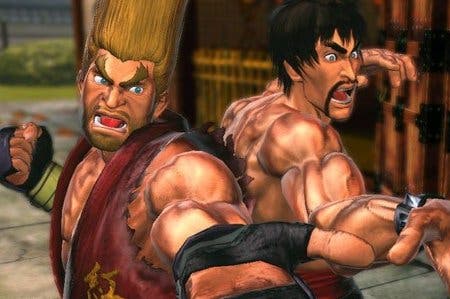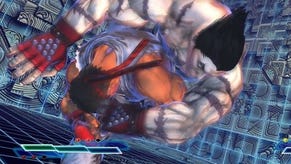Street Fighter X Tekken Preview: Year of the Dragon Punch?
Blocking the thighs and crossing the Steves.
Back when I worked in a game store selling third-party controllers to unsuspecting customers (on the basis that if I ever recommended an official pad, I'd be on permanent stockroom duty) an import-savvy shopper informed me that Famitsu had announced a crossover between Namco and Capcom. My automatic assumption was that this had to be a fighting game, and that Capcom had somehow struck a deal with Namco and was about to bring the likes of Ryu and Jin together in the ultimate 2D mash-up. Boy was I wrong.
Namco x Capcom turned out to be a tactical-RPG, and when a fan translation patch surfaced a few years later I saw for myself that this was a million miles off 'The King of Iron Fist Tournament with a Shadaloo twist' that I'd imagined. But it did get me thinking as to how a crossover between the world's most popular 2D and 3D fighting game franchises could ever work.
Street Fighter has always been about condensed command lists with special moves that rely on charge and circular motions, while Tekken is defined by its limb-based buttons that focus on juggling. And although they share the concept of one-on-one combat with health bars, multi-hit combos and a three round format, in every other respect they're the polarised bookends of a diverse genre.
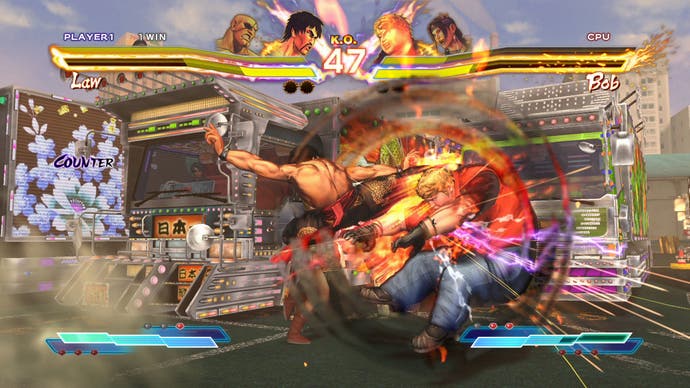
So when Yoshinori Ono and Katsuhiro Harada announced that their respective rosters would finally meet head-to-head in a clash of devil genes and raging demons, I was sceptical as to whether they could please one fan-base without alienating the other. The solution, however, proved to be a case of history repeating, as much like Capcom's prior dealings with SNK, this collaboration will result in two fighting games made independently of each other. And this time, Capcom is first off the starting block.
Playing Street Fighter X Tekken, it quickly becomes clear that Capcom has taken the template from Street Fighter IV and injected a healthy dose of Tekken Tag teamwork with a measure of Marvel vs. Capcom versatility. The result is a two-on-two fighting game that's unmistakably Street Fighter and yet undeniably different. And while the migration of Tekken characters to the Capcom way of thinking is a big part of this, it's also the underlying mechanics that offer a basic sense of familiarity - before challenging your notion of what's possible with a fresh set of subsystems.
Ryu and Ken can pester their opponent with fireballs while dragon punching obvious jumps - just as ever - but in terms of how they build flashy combos, the focus is less on solo assaults and more on starting a combo with one character and then finishing it off with the other. This relates to the Boost Combo system that works exactly like Marvel 3's chain combos, letting you effortlessly combo upwards from light to launcher. The only difference is that instead of propelling your opponent into the stratosphere, the final blow executes a Cross Rush that leaves them in a juggle-like state as you switch characters.
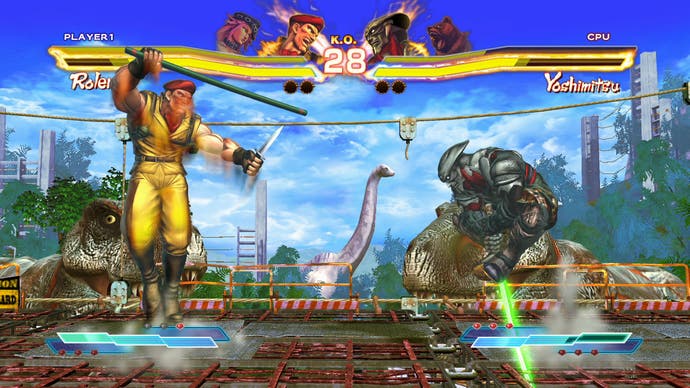
But far from overshadowing the more traditional links (which require precise timing as opposed to cancelling normal attacks into each other), it's best to use chains and links together before spending your meter reserves on a solo Super or tandem Cross Art. The super gauge even funds EX specials - as in Third Strike - and in an interesting twist, each character has a special move that can be charged into an EX or Super. These are easy to see coming but can prove useful in certain situations.
The more advanced gameplay mechanics revolve around the Switch Cancel, Cross Assault and Pandora systems - with Switch Cancel letting you tag during an attack animation to extend combos, setup mix-ups and cover whiffs for a little meter. Cross Assault, meanwhile, is similar to the Variable Cross system from Clash of Super Heroes in that it lets you fight with both characters simultaneously. But rather than being overpowered, it's more akin to a custom combo in that it lets you get creative with your AI-controlled partner for a coordinated offence.
And unlike the significantly more frantic MVC 3, it only takes one knockout to end the round - unless you sacrifice your point character. This relates to the controversial Pandora mode that powers up your benched character for seven seconds before you lose the round. This narrow window makes Pandora less overbearing than many other comeback mechanics. You can also combo into Pandora with certain moves like Sagat's EX Tiger Knee - which now causes a wall bounce - leaving plenty of time for a red-eyed Ryu to jump in with his patented Shinku Hadoken.
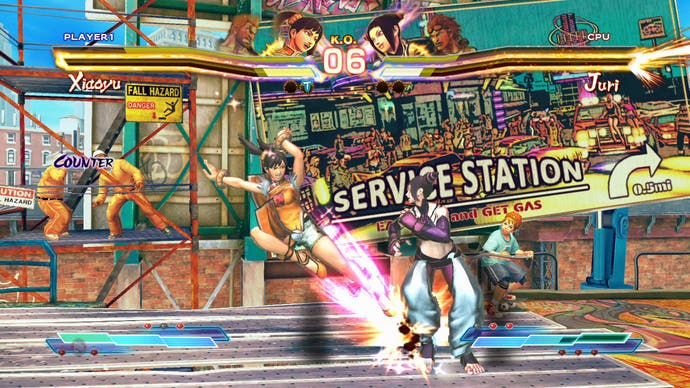
You can even start the aforementioned combo with a Ryu cross-up before linking two crouching medium punches and then tagging Sagat in with a Boost Combo that ends in a Cross Rush. That may sound baffling, but the relative ease in which it can be done is an indication that Capcom is trying to lower the point of entry for newcomers by making advanced combos easier to perform, as well as offering a flexible set of mechanics for hardcore fans to sink their teeth into. But despite this dramatic shift, it's the transition of Tekken to 2D that steals the show.
As a Law player since Tekken 3, I've seen the Jeet-Kune-Do master evolve across the series, and in Street Fighter X Tekken, he retains many of his trademark tools. His specials include an anti-air Somersault Kick which can combo five times in the corner and a ten-hit Fury Fist Rush that ends in a launcher, ground bounce or knockback. But unlike the Capcom equivalent of Cammy or Rufus - who rely more on dive kicks to apply their offensive pressure - Law can rushdown with eight target combos that mimic his Tekken combinations.
This is indicative of the Street Fighter X Tekken divide, as while most of the Capcom characters have a single target combo to their name (with Ibuki being the only major exception), the Namco fighters, on average, have between five to ten at their disposal. The effect this has is fairly profound; the Tekken tenants retain their multi-hit pressure and juggle focus while embracing a special move system that includes Marduk's lunging throw, Asuka's tricky counter and Yoshimitsu's classic suicide stab. Steve even keeps the evade buttons which have always stood-in for his kicks.

So it seems that while Capcom has made this crossover in its own image - with individual combo Trials and a large collection of Titles for online play - it's also trying to entice Tekken purists who've traditionally overlooked its twitchier games in favour of more realistic combat. And so to give new and defecting players a smoother transition to the world of cross-ups, overheads and chip damage - as well as affording veterans an extra layer of customisation - Capcom has introduced the controversial Gem system.
This lets you pick up to three Gems that activate when certain conditions are met. Boost Gems - which are targeted at anyone who's ever held an arcade stick - offer around a 10 to 30 percent increase in Attack, Defence, Speed, Vitality or Super Gauge with activation conditions that range from connecting with five normals and blocking ten times, to performing one reversal. The far less numerous Assist Gems, meanwhile, are aimed at beginners and include an Auto Block that drains your super gauge and a Super Easy Input that decreases attack power, but lets you perform a Spinning Piledriver by simply pressing up and punch.
Tailoring your Gem setup to - for instance - temporarily increase your speed and meter-acquisition will help you land a crippling Cross Art earlier in the fight. But in terms of the matches I've played so far, none of the Gems have had a massive impact on the outcome. They don't give one player an advantage over the other, but they do provide extra flexibility when it comes to choosing a team - although if Capcom offer additional Gems as pre-order bonuses and DLC, then it could be that some players have more options than others.
But as it stands, Street Fighter X Tekken is looking like a combative crossover that will unify the world warriors and iron fist fighters in impressive fashion. The only question is whether Capcom can include enough single and online multiplayer content to keep casual fans contented while levelling out the playing field enough to see long-term interest from the fighting game community.
